[Weekender] Staying relevant to the neighborhood
Two Michelin-star chef Corey Lee of San Francisco’s Benu talks about finding inspiration in moods rather than ingredients
By Korea HeraldPublished : May 23, 2014 - 20:09
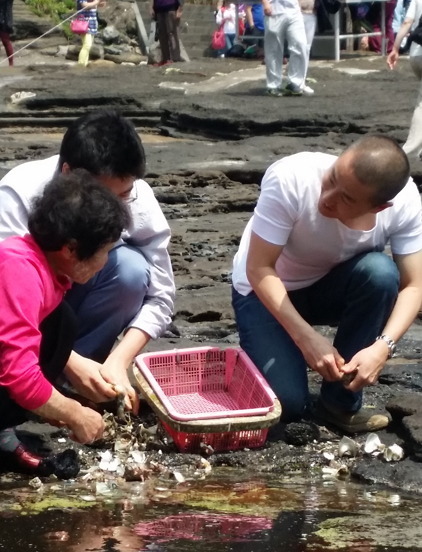
SEOGWIPO, Jeju ― It is not every day that a two Michelin-star chef from San Francisco gets tips on shucking a conch from a grandma.
But then, this is no ordinary grandma: she is a hardy haenyeo, one of the celebrated women divers of Jejudo Island.
Corey Lee, 36, the owner-chef of the critically acclaimed Benu, has just picked out some conch at a beachside eatery operated by the local haenyeo collective. The haenyeo leads him to the edge of the water, where she squats and begins shucking the conches.
“No knife. You will lose too much meat using a knife. Crack it open with a stone,” she says, picking up a pebble from the beach and demonstrating how. The experience is a novel one for Lee, who has been in the restaurant business since age 17 when he “accidentally” fell into it.
But then, this is no ordinary grandma: she is a hardy haenyeo, one of the celebrated women divers of Jejudo Island.
Corey Lee, 36, the owner-chef of the critically acclaimed Benu, has just picked out some conch at a beachside eatery operated by the local haenyeo collective. The haenyeo leads him to the edge of the water, where she squats and begins shucking the conches.
“No knife. You will lose too much meat using a knife. Crack it open with a stone,” she says, picking up a pebble from the beach and demonstrating how. The experience is a novel one for Lee, who has been in the restaurant business since age 17 when he “accidentally” fell into it.
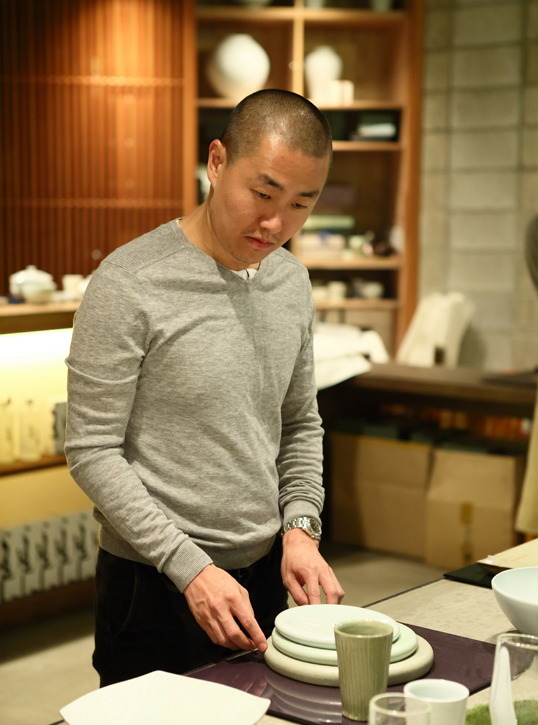
Back in the kitchen, Lee is scolded and chided with good humor by a group of women who are teaching him how to clean the conch their way. He is at ease thinly slicing the conch using a humble-looking knife and an old wooden cutting block, a far cry from his very modern San Francisco kitchen.
Lee is given the honor of seasoning the pot of conch soup with salt. When it is just right, he expertly ladles the soup into bowls.
For the world-famous chef, the women have prepared a simple, homey soup.
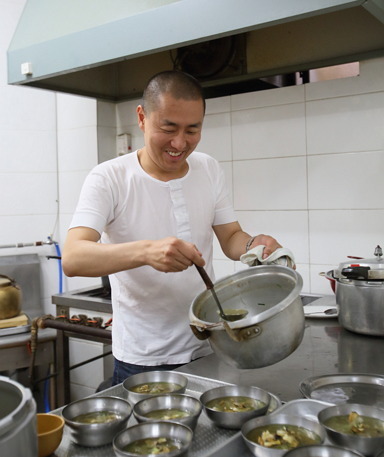
“It has been 55 years since I last had this soup,” says the veteran haenyeo who prepared the dish. The briny taste of the fresh conch is subdued by julienned radish, chives and buckwheat flour that add bulk to the soup.
“Those were the poor days, and buckwheat was our source of grain,” explains Hong Eun-pyo, head of the Seongsan-ri fishing village cooperative, savoring the soup and the memories it held.
Food is evocative of memories: For novelist Marcel Proust, it was the madeleine in his “Remembrance of Things Past”; for Lee, it was the Korean food cooked by his mom and grandma in New York that kept him connected him to Korea, the country that he left as a young boy.
The young boy, who enjoyed eating, opened a restaurant in August 2010, not yet quite 33 years old. Yet, having started at the Blue Ribbon in New York City at 17, he had, by 2010, been with the acclaimed chef Thomas Keller for eight years. For four of those years he was the head chef of The French Laundry in California, on top of his experiences in the A-list kitchens of Europe. His talent was already well appreciated ― Lee received the “Rising Star Chef” award from the James Beard Foundation in 2006.
“I started my own restaurant because I wanted to create new ideas, exploring different flavors and ingredients,” says Lee at the seaside restaurant on Wednesday morning. As he grew older, he found himself turning more toward his roots as a Korean and an Asian, and this was not suitable for a French restaurant. “I couldn’t explore some things that I wanted to,” recalls Lee.
The 62-seat Benu thrived, making a two-star debut in the Michelin Guide and quickly becoming a destination restaurant.
“Eastern flavors inspired me and we have cuisine that represents San Francisco, a city that is highly influenced by Asia,” says Lee. San Francisco has a large Cantonese community ― 40 percent of the population of San Francisco is Chinese.
Lee is in Korea for a week, accompanied by photographer Eric Wolfinger, working on a book that is due out next spring.
“I have been working on it for 1 1/2 years and it is about my experience as a chef,” says Lee.
In Korea, he is visiting Sunchang, Damyang, Buan and Jeju as well as Seoul, exploring regional food and specialties. This is the first time in 17 years that he has traveled in Korea beyond Seoul, although he returns to Korea every year now.
“The book will have photos that are more evocative of culture. For example, haenyeo are symbolic of Korea. It will capture landscapes, cityscapes, visually explaining my inspirations,” Lee says.
Hong Kong will also be presented as his inspiration in the book that will also feature 25-26 courses, with a narrative to accompany each dish.
“When I was younger, specific ingredients inspired me. But as I get older and travel more, I am inspired by things like mood, aesthetics that are not about food,” Lee says.
“Today, for example, the mood involves the quiet, the melancholy, the ocean and haenyeo doing very hard work. This would be interpreted into a quiet, subtle dish that lingers more, and one can contemplate on it,” Lee says.
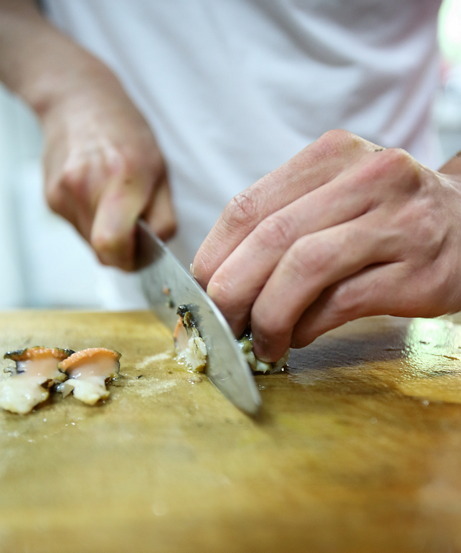
At Benu, Lee serves a 19-course tasting menu that can take about three hours to enjoy. “Our menu is not all approachable. There is an ebb and flow between the challenging and the comforting,” Lee explains.
“It is difficult to explain what kind of food we serve. We are limited by vocabulary in explaining our food,” he says of the term “contemporary American cuisine” that is used to describe Benu’s offerings.
“For me, the term means diversity, a ‘melting pot,’ nontraditional, forward-thinking,” Lee proffers.
Some Korean ingredients are easily noticeable at Benu. “Kimchi, pork belly, and oyster are distinctly Korean-influenced dishes,” says Lee. The unnoticeable are jang, stocks and bases. “We use anchovy stock, seaweed stock and clean, clear bases.
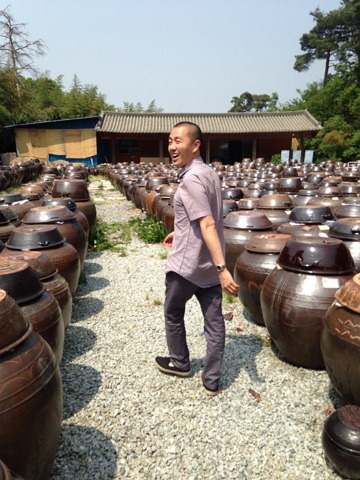
“It is about securing the balance of sugar, savoriness, saltiness,” adds Lee, who observes that these are more balanced in Korean cuisine than other cuisines. “This is because most Western cooking is seasoned with salt while in Korean cooking ‘jang’ is used.” “Jang” are seasonings made using fermented soy beans.
Lee’s favorite ingredient is rice. “It is comforting food. It is a medium for intense flavors, or it can stand on its own. It can be Eastern or Western, it is very versatile. This is what makes it universal,” Lee says.
The food that will be served at his second restaurant, Monsieur Benjamin, due to open next month, will be very different from that offered at Benu. Set in the performing arts district of Hayes Valley, the 100-seat Parisian-style bistro will serve a large menu of classical French dishes with California ingredients and traditional bistro flavors.
“The hallmark of a bistro is relevance in the neighborhood and an urban feel,” Lee says.
“Being a chef is physical and it is creative and artistic,” says Lee. “We’re craftsmen first, but we can’t wait for the next inspiration, and cannot think of ourselves as artists. Yet, at the highest level, it satisfies all the senses and it is most subjective.
“Food is ephemeral. It is a very personal way to experience someone’s vision,” says Lee.
How does the acclaimed chef eat at home? When it comes to his own meals, he is very simple ― he never gets to eat at home and eats only one meal a day ― dinner at the restaurant at 4:30 p.m. “At noon we have a smoothie made with left-over bits of vegetables and fruits,” says Lee.
By Kim Hoo-ran (khooran@heraldcorp.com)
-
Articles by Korea Herald








![[Graphic News] More Koreans say they plan long-distance trips this year](http://res.heraldm.com/phpwas/restmb_idxmake.php?idx=644&simg=/content/image/2024/04/17/20240417050828_0.gif&u=)
![[KH Explains] Hyundai's full hybrid edge to pay off amid slow transition to pure EVs](http://res.heraldm.com/phpwas/restmb_idxmake.php?idx=644&simg=/content/image/2024/04/18/20240418050645_0.jpg&u=20240419100350)






![[From the Scene] Monks, Buddhists hail return of remains of Buddhas](http://res.heraldm.com/phpwas/restmb_idxmake.php?idx=652&simg=/content/image/2024/04/19/20240419050617_0.jpg&u=20240419175937)

![[KH Explains] Hyundai's full hybrid edge to pay off amid slow transition to pure EVs](http://res.heraldm.com/phpwas/restmb_idxmake.php?idx=652&simg=/content/image/2024/04/18/20240418050645_0.jpg&u=20240419100350)

![[Today’s K-pop] Illit drops debut single remix](http://res.heraldm.com/phpwas/restmb_idxmake.php?idx=642&simg=/content/image/2024/04/19/20240419050612_0.jpg&u=)